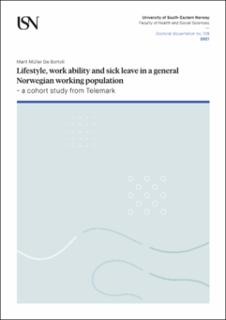| dc.description.abstract | Background: The sustainability of the Norwegian welfare state is being challenged by
demographic changes. One consequence of increased life expectancy is that the working
population is expected to work longer. Good mental and physical health is considered a
key prerequisite for an extended working life. Previous studies have identified several
associations between independent lifestyle risk factors, work ability and sick leave.
However, few studies have investigated these associations using a summative lifestyle
risk index.
Aim: The aim of this thesis was to investigate potential associations between multiple
lifestyle risk factors, work ability and sick leave in a general working population in
Telemark County in south-eastern Norway. A further aim was to explore such associations
within different non-communicable disease groups.
Materials and method: At baseline of the longitudinal Telemark Study (2013),
a selfadministered questionnaire was posted to 50 000 persons aged 16–50 in both rural
and urban parts of Telemark County. Of these persons, 48 142 were eligible and a total of
16099 completed and returned the questionnaire. The questionnaire covered the
following areas: personal information, working conditions, respiratory symptoms,
respiratory symptoms and work, smoking and snuff habits, living conditions, childhood
and family, physical activity and diet, and other diseases and illnesses.
In 2018, a five-year follow-up questionnaire was sent to the 16 099 persons who had
responded in 2013. In total, 7 952 persons completed both questionnaires (2013 and
2018).
Logistic regression analysis was used to explore the associations between multiple
lifestyle risk factors, work ability and sick leave. Other statistical analyses were also
performed, including interaction analysis, correlation and association testing, and
calculation of the population attributable fraction.
Main results: All subjects included in Paper I and Paper II had worked in the preceding 12
months and answered the questions on work ability and lifestyle risk factors (n=10 355).
In Paper I, individual lifestyle risk factors and a lifestyle risk index were associated with
reduced work ability. This finding remained consistent after adjustment for age, sex,
current occupation and education. In Paper II, physician-diagnosed asthma was found to
be an effect modifier in the association between lifestyle risk factors (obesity, smoking
and lifestyle risk index) and sick leave.
Paper III included individuals who had been engaged in work in the preceding 12 months
at both baseline and follow-up (n=6 267). The study found that unhealthy diet, low
physical activity and smoking were associated with low work ability. This finding remained
consistent after adjustment for potential confounders (Paper III). Further, the study
showed that high body mass index, former and current smoking, and high and very high
lifestyle risk indices were associated with higher rates of sick leave. Former smoking was
associated with low work ability among persons who reported mental illness, while
current smoking was associated with sick leave among persons who reported
cardiovascular disease, diabetes or mental illness (Paper III).
Conclusion: Based on these three papers, this thesis suggests that individual lifestyle risk
factors may be linked to lower work ability and higher rates of sick leave. In particular,
poor work ability was associated with a higher lifestyle risk index score. This was also
shown for sick leave at follow-up. In all three studies, smoking was consistently
associated with low work ability and increased sick leave (Papers I–III).
Lastly, physician-diagnosed asthma was an effect modifier in the association between
obesity, smoking and lifestyle risk index and sick leave (Paper II). These findings add to
current knowledge and support the hypothesis that policies aimed at reducing lifestyle risk factors may benefit population health and extend working life.
Also, as smoking is particularly linked to a social gradient in health, this finding warrants
future attention. Future studies examining lifestyle risk factors may benefit from the
inclusion of co-occurring lifestyle risk factors and the assessment of work measures
(i.e. work ability and sick leave) as outcomes considering socioeconomic differences. | en_US |

